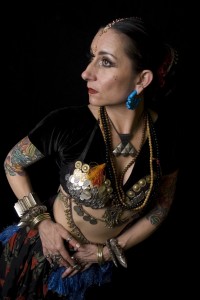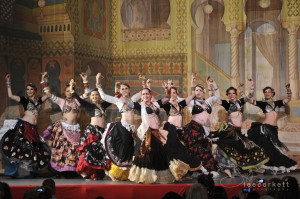The sun never sets on American Tribal Style Belly Dance®. From Sydney to Stockholm, and Tel-Aviv to Taipei, one can find an American Tribal Style® (ATS®) class in more than 270 studios in 20 countries—including 151 studios in 37 US states and Puerto Rico. Ground zero for this modern fusion of North African and Middle Eastern dance forms is San Francisco’s Mission District, where ATS’s creator, Carolena Nericcio, operates the FatChanceBellyDance® Studio and Resource center.

But before we get to Carolena, and ATS, a little context is in order. Imparting the full history of belly dance is a task better suited for a book, so please note that this is a very simple review of the roots of ATS1. In 1893, indigenous dances of North Africa and the Middle East were introduced to the United States at the Columbian Exposition in Chicago, and then appropriated into American culture through exoticized depictions in movies and burlesque shows. Elements of these exoticized forms were then re-appropriated by Egyptian dancers and transformed in the 1930s into what is still known today as Egyptian Cabaret Style.
The roots of ATS are found in the work of Jamila Salimpour, a dancer who studied Egyptian dance and recognized possibilities for combining of different Middle Eastern and Arabic dance forms. She created a new vocabulary for belly dance, based on frequently repeated movements she saw in what were normally considered improvised dances. She moved to San Francisco in 1958 and began teaching and eventually performing with her company Bal-Anat.
One of Jamila’s students, Masha Archer, formed her own company, San Francisco Classical Dance, in the early 70s. Masha fused many different forms of dance in a form she simply called “belly dance.” She also drew on a much wider set of cultural and folkloric styles for costuming and music, including Indian and European traditions. Carolena was one of Masha’s students.
After San Francisco Classical Dance disbanded, Carolena began teaching her own classes in a studio at Noe Valley Ministry in 1987. She began teaching what she learned from Masha, but returned to a primary focus on North African and Middle Eastern dance and costuming traditions, although ATS has incorporated elements of Flamenco and East Asian dance into its vocabulary of movement. Unlike the single dancer of Egyptian Cabaret Style, women dance ATS as a group, with choruses and formations.
The name “American Tribal Style” came about when belly dance traditionalist took umbrage with Carolena describing what she was doing as belly dance. She recalls:
“I didn’t mean to step on the toes of the traditionalists; I just didn’t want to have anything to do with what they were doing. It’s not my thing, and it’s not what I was raised in. I didn’t want to argue with them about it not being real, because I knew it wasn’t real. I also knew that people who didn’t know the difference were seeing what I do as the real thing, so I understood the conundrum. Eventually a prominent dancer named Morocco, from New York, called it American Tribal Style Belly Dance—American because it came out of fusion of forms that is uniquely American, tribal because it’s danced as a group, and style meaning it’s just a style—it’s not purporting to be an authentic North African or Middle Eastern tradition. I just accepted it and thought to myself, good. Now can I go play?”
As her classes grew, Carolena opened her own studio and core performing company, named FatChanceBellyDance. San Francisco is famous for its transitory population, and people who had been studying with Carolena moved elsewhere, and wanted to teach what they had learned. This began the process that lead to American Tribal Style’s global expansion.
“It got out of control, and some of what was being taught under the name ATS was so different from what I was teaching. I was trying to tighten my ideas and concepts, while other people were taking what I was doing and making something totally different with it. Eventually, to help standardize the form, I offered a 4 day intensive called General Skills, which immerses you in all the concepts, all the steps, all the formations, all the performances.
“People who advanced to a point where they could take General Skills and teach ATS told me they wanted their Studios to be affiliated with FatChanceBellyDance, so we created Sister Studios. Some people teach only ATS just like we do here, but for others it’s one component of what they teach.
“Recently we trademarked the name ‘American Tribal Style Belly Dance.’ People are free to use the term and don’t have to pay me anything, but they need to do ATS. It’s fine if people want to take it and then create something else, they can’t call it ATS.”
My own introduction to FatChanceBellyDance reveals some of the challenges of perception that many newcomers have with ATS. Watching FatChanceBellyDance I felt as if I was watching something from the distant past, but I was actually watching something less than 30 years old.

“The problem is that people who have really never seen belly dance see us for the first time, they think they’re watching something folkloric and original, and that the sparkly girl in the pink chiffon outfit [in traditional Egyptian Cabaret Style] is a fantasy, but it’s the reverse. The pink sequined outfit is actually a very powerful statement from its time. You have to imagine living in Egypt or Turkey in the 1930s. It was an empowering way for a woman to make her own money and be visible. That is an authentic tradition.
“I think audiences see ATS and feel they are being transported back to a different time, but they are watching something contemporary. It is a successful fantasy and looks like you’re watching tribal dancers out in the desert. Even when people find out that they’re watching a fantasy, they still want to see it as authentic.”
More widespread, and equally difficult to overcome, are continuing stereotypes about belly dance in general. Belly dance is an empowering way for women to celebrate their femininity, their bodies, and their friendships, but societal views about belly dance are implied in the name of Carolena’s company. The “fat chance” in FatChanceBellyDance is the response to men who would watch the dance and then ask for a private show, or something more.
“The majority of people who hear the word belly dance, male or female, imagine a false stereotype. When I tell people what I do, I say I’m a dancer and I resist adding “belly dancer” because I want to have as much of an actual conversation as possible before they drop out.
“Every belly dancer you talk to wishes they didn’t get that response. My desire is to help push it out of the realm of fantasy and hoochie-coochie and into the realm of a respected tribal folk art. And something that makes women feel good about dancing together.
“The definitive part of this form is the community of women. Even if women come to the studio just looking for a workout, they leave with a powerful sense of female camaraderie.”
The FatChanceBellyDance studio is immersed in the textile artistry and beautiful jewelry which is vital to the presentation of ATS, but which has also helped the studio build a successful business outside of the non-profit dance company business model.
“My ability to continue as an artist is tied to a number of revenue streams that go beyond teaching. We sell jewelry and costumes, offer consulting, and manufacture instructional DVDs. We make the products that promote the form and help pay the salaries.
“I’ve considered taking the company non-profit, but it doesn’t seem worthwhile. We are a modern dance company, but we don’t look like ‘modern’ dance. We aren’t tied to a particular culture, and it would be incorrect to call us traditional. We just don’t fit into pre-conceived categories used by funders in deciding how to distribute their funding. Fortunately, we’ve found a solution in the support of our community, and through new crowdsourced fundraising tools. We’ve turned to Kickstarter to raise funds for our June show, Devotion, and with success, this kind of fundraising could play a bigger role in supporting FatChanceBellyDance.”
This spring Carolena and company will be touring and teaching and continuing to spread the gospel of American Tribal Style. In June they will present their yearly Devotion performance at the Julia Morgan Theater in Berkeley. Devotion has brought guest dancers from around the world to share the stage with the FatChanceBellyDance. Watching a Devotion performance, one sees that the American Tribal Style community, separated by great distance, is as close in spirit as a dance community can be. A worldwide community of women, connected at the hip.
1 More detailed history can be found at fbcd.com. For information on Tribal, and other styles of Belly dance, visit gildedserpent.com.
This article appeared in the April 2013 issue of In Dance.

